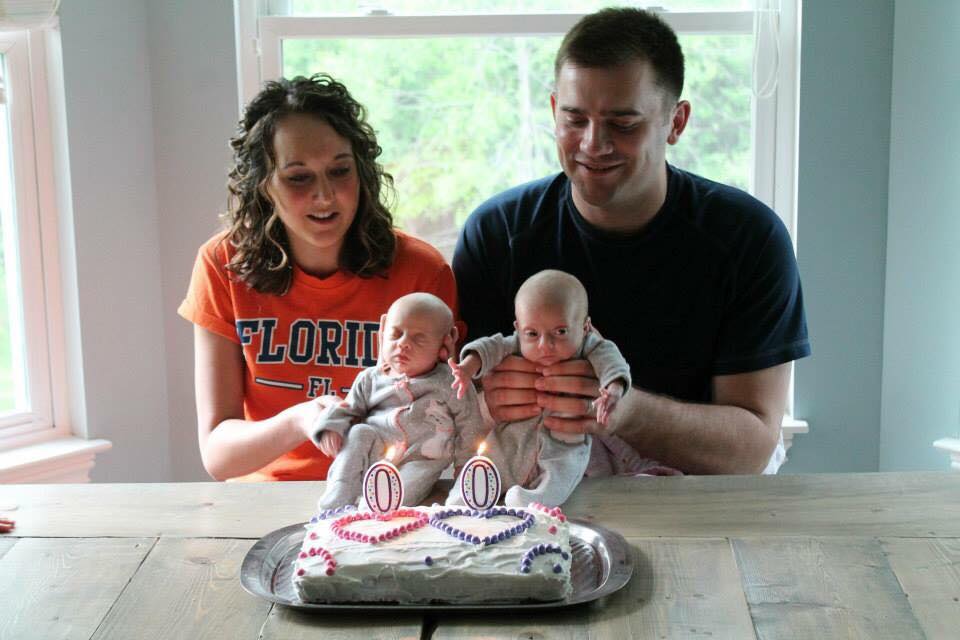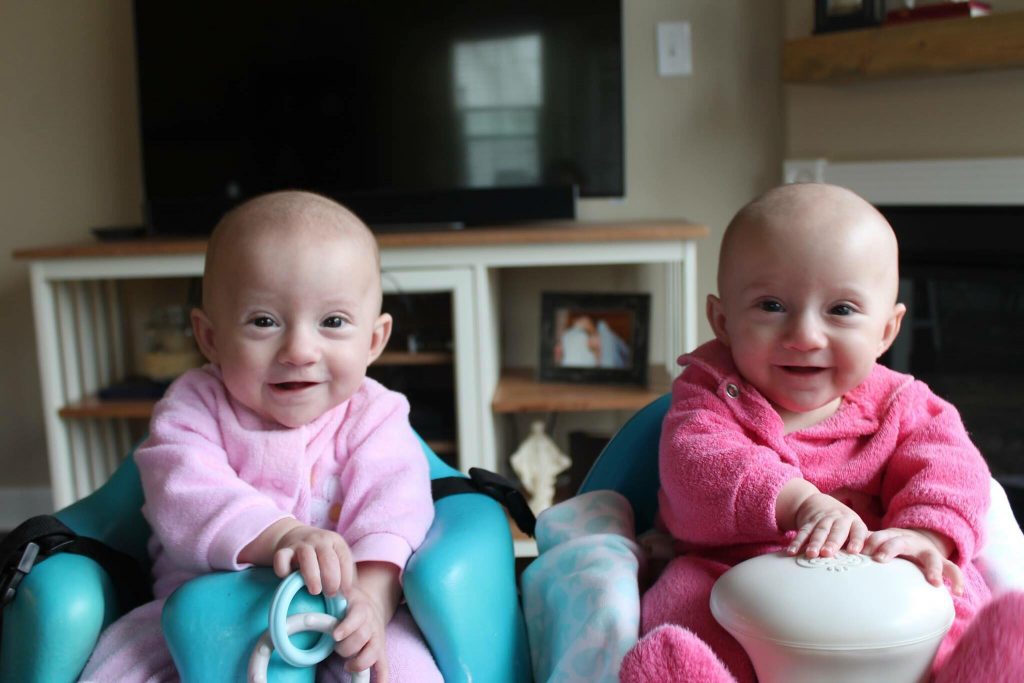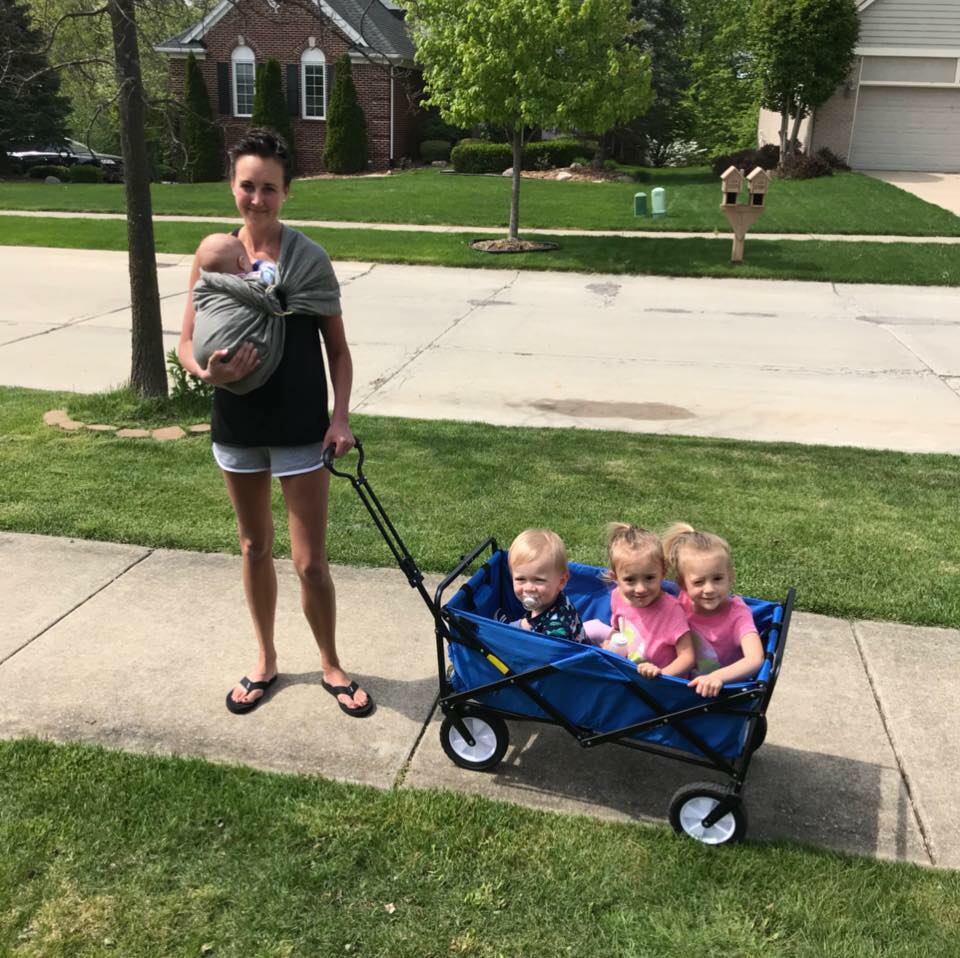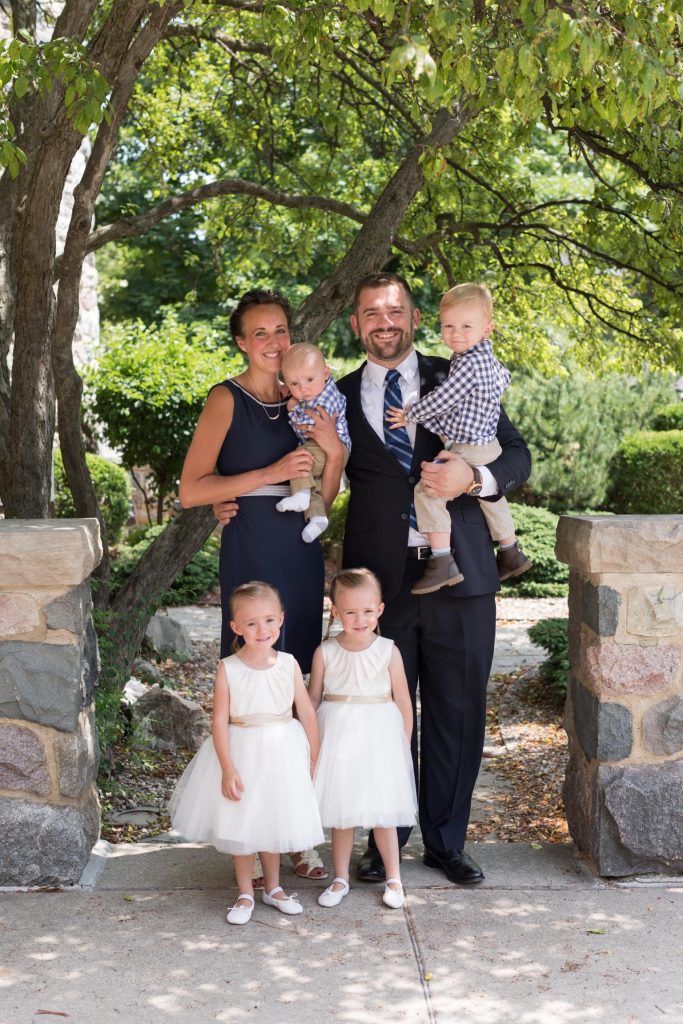Our twins, Gianna and Chiara, shouldn’t be here, according to medical professionals.
At twenty weeks gestation, it was discovered that the twins had Selective Intrauterine Growth Restriction. This meant that the placenta they shared was unevenly divided (though it was unclear how unevenly at the time) and one twin, Chiara, was receiving only a fraction of the nutrients she needed to survive.
At twenty-two weeks, we were told Chiara’s condition had reached the point where she would pass away any day and, because of the rapid shift in blood flow, Gianna shortly after. We were told no baby had survived beyond a week, two at the absolute most, once they had reached this point.
Nearly nine weeks later, on March 16, 2015, our beautiful, strong, tiny fighters were born weighing 1 lb 13 oz and 2 lb 11oz. The doctors’ response? “We have no explanation for this. It is truly a miracle.”

After a six and a half week stay in the NICU, we brought our girls home. Overall, those first few weeks out of the hospital went about as we expected. We were exhausted, but that was unsurprising, and I found myself pumping every two hours around the clock because the girls were unable to maintain their weight while nursing.
The most challenging part was that the girls’ gag reflex had not fully developed by the time we brought them home. So, instead of coughing when they gagged on their milk, like a normally-developed baby would do, they would “shut down” and stop breathing.
Since this was a silent reaction, we had to watch them very carefully with every feed. They’d be slowly and steadily gulping their milk until, suddenly, the color would drain from their faces and they’d become limp. The only way to snap them out of it was to flip over our tiny 3.5 lb and 4 lb babies onto their stomachs and whack their backs until we heard them breathing again. Was it terrifying? Yes. But, thankfully, their reflexes developed after a few weeks.
In May of that year, we were told my husband, an engineer in the United States Coast Guard, was going to be transferred to Cleveland, Ohio. Our doctors wrote letters to the Coast Guard expressing their concern over moving us away from the family, friend, and medical support system we had in our hometown in Michigan.
The letters made no difference, however, and the following month we found ourselves in a new city away from all of our family and friends.

Not long after our arrival in Cleveland, the girls developed severe reflux. They began projectile vomiting the entire volume they had just consumed after nearly every bottle.
We discussed this with our new pediatrician on many, many occasions, but the response we received every time was that we were being “overly hyper first-time parents,” and that they would eventually grow out of it.
The girls did not grow out of it, however, but continued to get worse.
Eventually, the girls began to associate the pain of vomiting with their bottles, and started rejecting nearly every bottle we offered them. As the days turned into weeks, and the weeks into months, the volume the girls’ consumed each day grew less and less. We had to feed the girls about every two hours around the clock, and would record every ounce they consumed so that we had concrete evidence to bring to our pediatrician.
My life at this point in time was completely consumed by my efforts to get the girls to eat.
I would pump for twenty minutes, try one baby with the bottle for forty-five minutes to an hour, try the next baby with the same bottle for forty-five minutes to an hour, record the two or three ounces they had consumed, dump the remainder of the bottle because it was fortified with formula and would have expired by that point, and begin the process over.
Every day and all through the night this was the process for months on end, combined with scrubbing the girls’ vomit from the floors, walls, and furniture. I can remember sitting on my bed and sobbing for hours as I stared into the faces of my beautiful, sweet babies, whom I knew were starving to death.

I had never felt so incompetent in my life, never more like a failure than I did during those months in Cleveland. After all, I was incapable of accomplishing one of the most basic duties of a mother: feeding my children.
My experience of motherhood looked so drastically different from what I had expected. I couldn’t leave the house because the demands of pumping and trying to get the girls to eat consumed nearly every second of my time. Most weeks, I only left the house for church on Sunday.
I was lonely, mentally and physically exhausted, and my thoughts were completely consumed by the stress of trying to feed the girls. I felt defeated and helpless, and all I kept thinking was: why would God perform such a miracle to bring my little ones into this world, only to have them (and, selfishly, myself) suffer so greatly?
My husband and I knew that I needed better support, so we began praying novenas to St. Jude, the patron saint of impossible causes, and offered them for the Coast Guard to allow our transfer back to Michigan to be with family. We had been told it would be nearly impossible to receive their approval, but God had worked miracles in our lives before, and so we prayed with hope.
In the midst of all this anxiety, frustration, and fear, I found myself pregnant.
My husband and I have always been open to life, but it wasn’t until I gazed dazedly at those two pink lines that the reality of welcoming another child into our family really sunk in.
The twins were seven months old, and only weighed about 8 lb each at this point, so I felt as though I still had two newborns. Not to mention, they were still fed every two hours around the clock, and their needs were far greater than most newborns.
I was overwhelmed, to say the least, and couldn’t fathom adding more stress to what I was already experiencing. However, about two weeks later, I lost the baby (our third miscarriage, since I had lost two before the twins). I was devastated, and I felt guilty for having felt anything other than joy when I was pregnant. It wasn’t until I experienced the loss of this life that I realized how desperately in love I was with this baby, and how beautiful, precious, and miraculous every life truly is.
Only a few weeks later, I found out I was pregnant again. And this time, I was able to wholeheartedly embrace the life I had inside me, surrender my will to God’s, and place my trust in Him. It was challenging to be sick and even more exhausted in the midst of all I had going on with the girls, but I was overjoyed to be bringing another life into the world.
By the end of the year, I was recording milliliters for each bottle I offered the girls, and they were consuming about six ounces of milk over the course of twenty-four hours: clearly not enough to survive.

The only way we were able to get them to eat anything was to slip a bottle into their mouths while they were in a deep sleep. I can remember lifting them from their sleepers, ever so carefully and slowly, praying they would stay asleep. If they happened to wake up, we had to wait until they fell back into a deep sleep to try again.
It was at this point that our pediatrician acknowledged that he had made a mistake, and the girls were hospitalized for fear of dehydration and malnutrition.
During their hospital stay, the girls were given NG-tubes to try to make up for some of the nutrition they had lost over the past several months.
We assumed the tubes would be a temporary measure, but this was not to be the case. The days turned into weeks, and the weeks into months, and the girls’ gagging and vomiting grew worse, exacerbated by the tubes down their throats. Even a simple cough would trigger gagging that eventually led to vomiting. The girls would often vomit the tubes halfway out which, consequently, would trigger even more violent gagging and vomiting until I was able to pull the tube out.
This was particularly scary while I was driving. I resorted to driving on back roads everywhere I went so I could more easily pull over and jump out to remove the tubes and stop the vomiting.
Putting the tubes in was certainly no easy task, either. Since I was often by myself with the girls, I would have to lay them on their backs, pin their arms and legs down by holding them firmly between my legs, and feed the tube through their nose and down their throat until it reached their stomachs, all while they screamed and tried to break free. It absolutely broke my mother’s heart to inflict so much discomfort on my babies.
Due to the girls’ hospitalization and new situation with the NG-tubes, the Coast Guard granted our request to be transferred to a better family support system in Michigan. This was an incredible answer to our prayers, and a miracle in and of itself. In our gratitude, we promised St. Jude that we would name our baby, due in August, after him.
A few months after the girls received their NG-tubes, Dan and I made the difficult decision to have G-tubes placed, small ports that are surgically implanted in their bellies through which they would receive their feeds via a pump.
The surgeries went well, and the every-day vomiting episodes were drastically decreased. Shortly after the G-tubes were placed, the girls began seeing an occupational therapist. The therapist worked diligently with the girls every week to increase the amount of textured foods they were able to consume.

After months of hard work, Gianna was eventually weaned off her G-tube, although her cooperation and the amount she consumed each day was incredibly variable. She had the occasional meal, even a full day, where she would eat a decent amount. However, she would frequently fall into “eating ruts” where she would go days or weeks eating hardly anything. She would turn away, cover her face, or throw a tantrum when food was placed in front of her.
Additionally, when we got her to take a bite, she would “pocket” the food, holding it in her cheek for sometimes an hour or more. It was stressful and exhausting, but we were grateful she was off her tube, and prayed her acceptance of food would improve over time.
Chiara, on the other hand, was still entirely dependent on her tube feedings. When we tried to feed her table food, she would gag and often vomit.
Eventually, she began vomiting at just the sight of food. I would put her in the high chair, hold the spoon of food up to her mouth, and she would vomit everywhere.
So I would change her clothes, scrub down her chair, the floor, and often myself, offer her the next bite, and she would vomit again.
Meal after meal, day after day, this was the pattern. The stress of trying to feed my children was taking both a physical and mental toll on me. As each meal time approached, I would grow sick to my stomach with anxiety and stress; and in between each meal, I thought of nothing other than how little they had consumed at the previous meal, and what I was going to do to try to make up for it at the next.
Feeding my children became more anxiety-inducing than anything I had ever experienced. While most families spoke fondly of the memories they made around their table each day, the very thought of meal time often made me burst into tears.
At the end of that summer, we welcomed our third child, a little boy named Jude Xavier, into the world. He was amazing and perfect, and we were desperately in love with him. He had a lot of difficulty nursing, so I was only able to nurse him for a little over six months. However, he took a bottle decently well and, as he grew old enough to eat solid foods, we had very few issues feeding him.
I remember thinking to myself, “So this is what a normal child is like?”
As time went on, not much improved for our twin girls who were now 2.5 years old.
I was beginning to lose hope that we would ever see improvement in their eating. Then, we were made aware of an intensive feeding program at Mott Children’s Hospital at the University of Michigan, which was nearby. The girls were put on the waiting list, which we had heard was often two or more years long. Amazingly, though, only a few months later, Chiara was accepted into the program.
Since Gianna was no longer dependent on her G-tube, she was not accepted at this time, despite the challenges we still faced with feeding her. Chiara was scheduled to begin early- to mid-February.
The Hospital Program would require me to be at the hospital with her for eight hours every day, five days each week, for two months.
With another baby due in early March, and my husband working full time while attending business school at the University of Michigan on the weekends, this was obviously not ideal timing. However, we were willing to do anything to improve our girls’ eating.
On January 10th, the day my husband left for a ten-day business trip, I received a call from the clinic saying they had an unexpected opening, and was asked if we could start the following morning at 8:20am.
I was eight months pregnant by then, so waking up at 5 am to work out, pack separate bags for the hospital and for dropping Jude and Gianna off with my family, prepare food to bring to the clinic, and get out the door by 7:15 am was challenging. However, once we were at the hospital, I felt a huge wave of peace and relief knowing I wasn’t the only one responsible for feeding Chiara.
The doctors and other staff members at the clinic were absolutely incredible, and I cannot praise them enough.
After a week of bringing Chiara, they agreed to accept Gianna into the program as well, despite their already full patient schedule. Again, this was an amazing answer to our prayers.
The clinic discovered that Gianna had severe oral motor development issues that had gone unnoticed, which meant she basically didn’t know how to eat. She moved her tongue in odd ways in order to avoid certain overly-sensitive areas of her mouth, causing significant fatigue when she tried to chew. So rather than her refusals being behaviorally-induced, as we assumed, she would do everything in her power to avoid eating because it was incredibly difficult for her.
This broke my heart to hear, but I was so, so grateful we had finally determined a reason for her eating issues. Chiara had similar oral development issues as Gianna, but hers were even more severe because she had been tube-fed for so long. Her mouth was incredibly sensitive, which led to gagging and vomiting, so it was a long, pain-staking process to get her to the point where she could be weaned off her tube.
There was a lot of trial and error over the course of the program, steps forward and steps backward.
After a few weeks, the doctors had to go back to square one in order to teach both Gianna and Chiara how to eat, which meant their entire diet consisted of pureed table foods.
Both at the clinic and at home, the girls had to be spoon-fed every bite at every meal, while a timer was used to pace the meal. It was a time-consuming and labor-intensive process but, for the first time, I felt as though there were hope that the girls would improve.
A week before the girls were scheduled to graduate, I gave birth to our fourth baby, Benjamin Joseph (accidentally at home). Once again, we were in awe of how perfect he was, and were desperately in love with him.
Similar to Jude, Benjamin had a lot of difficulty nursing, due to his unusually high and narrow palate. He screamed every time I tried to nurse him which, consequently, often ended with me in tears as well. I saw lactation consultants, and tried every trick in the book to improve his latch, to no avail.
After about ten weeks of struggling, I made the decision to switch to bottles. It was a difficult decision, made particularly difficult by the guilt I felt in not giving my baby what I knew was best. However, after years of dealing with the stress and anxiety of feeding my children, I knew that what was best for me and, consequently, my family, was to take the least stress-inducing path. Benjamin was a bottle champ and, after a few stressful weeks of figuring out some reflux issues, he became a calm, happy, smart baby and a great eater.

The girls graduated from the feeding program on their third birthday. While we didn’t reach all the goals we had hoped we would reach at the onset of the program, the girls still made huge strides. Chiara was weaned completely from her tube feedings; the girls’ mouths had become far less sensitive; and their major oral motor issues were well on their way to being resolved.
However, both Gianna and Chiara were still spoon-fed purees, and every meal followed a very rigid protocol: three bites of puree for each, with fifteen seconds between each bite, and then thirty seconds between each set of three bites, for forty-five minutes. I also had to continue desensitizing the girls’ mouths with special textured brushes before each meal. It was complex and time-consuming, but I no longer dreaded each meal.
Unfortunately, around the time the girls began the feeding program, Jude began exhibiting the same refusal behaviors as Gianna at each meal. Thankfully, we recognized the oral motor issues early because of our past experiences, and the doctors at the feeding clinic offered to see Jude as well. Sure enough, Jude was diagnosed with the same oral development issues as Gianna.
In the months following the girls’ graduation from the feeding program, our family experienced quite a few changes. When Benjamin was only four months old, I found myself pregnant yet again. And in the same week I found out I was pregnant, my husband started a job that would take him out of town Monday through Thursday every week for the next six months.
This pregnancy was particularly challenging as I was very, very sick, and with my husband gone four days each week, meal time became increasingly stressful, yet again, as the girls made little progress once the program ended. So our journey is far from over.
While it is frustrating and stressful to be dealing with a third child with an eating disorder, we know we are in the best of hands at the Mott clinic, and are hopeful that his issues can be resolved.
Every week, I take all three to the hospital to work with the doctors and speech therapists at the clinic, and to devise new goals and plans for moving forward.

As I reflect on the past few years, and all that we have experienced (and still experience) with the kids’ eating disorders, it’s impossible for me to fully convey everything that comes to mind.
I wish I could say I had never felt closer to Our Lord than in the midst of our most challenging times; I wish I could say I trusted wholeheartedly in the plan Our Lord had laid out for me; I wish I could say I had always felt an overwhelming sense of peace and the strength I needed to get through each day.
But that was not the case. I spent so much of my time focusing on the challenges I faced, rather than asking God for the grace to overcome them. I spent so many hours of my day crying out to God for help, and yet never paused long enough to listen. When people asked me about our situation with the kids’ eating issues, I often felt overwhelmed by a sense of regret and guilt for not having embraced the cross God had bestowed upon me with more grace.
One morning, however, as I sat in Mass, the story of the blind man came to mind. It was not the gospel for the day, so I am not sure why I was reflecting on this story, in particular, other than that God had placed it on my heart.
What He revealed to me was that the blind man received two miracles. The first, was the physical healing he received in having his sight restored. This is the miracle we recognize, because it’s the most obvious: he was blind, and could see. The second, and more important miracle, was that his eyes and heart were opened to the wonder, power, and goodness of God. This wasn’t a miracle that ended in the moment his sight was restored, but a miracle with enduring consequences that he continued to experience day after day.
It suddenly became clear that this was how God was working in my life and what He was calling me to recognize today. The challenges we faced, and still face, with the girls on a day-to-day basis did not negate the physical miracle we had experienced while I was pregnant with the twins. Yes, He had granted life to our sweet babies who, according to every medical professional, should not be here.
However, and far more importantly, He had revealed that His hand is in all things; that He alone is the author of life; that His grace is enough; and that we are called to trust, no matter what the outcome. God had used the miraculous healing of the girls to show me that He is in all things; that he can do all things. If He wanted to heal the girls of their eating disorders instantly, He could – yet He was calling me to a deeper trust.
Trusting God isn’t a one-time thing. It’s not a decision that is made once. Every day, every minute, is a new opportunity to make the decision to trust: a new opportunity to begin again.
I used to focus so much on how I had “failed” in a given moment. If I completely lost it and had spent most of the morning crying, I gave up and looked at the entire day as a failure. “That’s it,” I would think to myself, “I’ve failed at being a mom today.”
As time went on, I realized that God was calling me to surrender every single second of every single day. So what if I sobbed during the last meal? There was going to be another meal to try again. Did I regret putting the kids to bed while feeling completely overwhelmed with frustration? Absolutely. But they were going to wake up, and I had a chance to try again with more patience.
I regret the months I spent completely consumed by the girls’ eating disorders because I know God had so much more to give me; so much more that I was refusing to accept. The grace to handle any situation, and to trust without reserve, is always available, if we simply ask for it.
While I wish I could say I had never felt closer to God than in the midst of my hardest months with the twins, that doesn’t mean He was not present. His arms were opened wide, just waiting for me to surrender myself to His loving embrace with complete, reckless abandon. I still spend many days in tears as I struggle with the kids’ eating disorders; I still have a lot to learn, and a lot of growing to do.
But right now, in this moment, I’m choosing to trust.

This image and this article feature image are by Melanie Reyes Photography.
